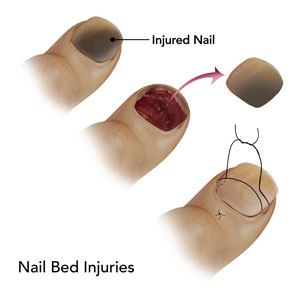
Nail Anatomy
Nails cover the tips of the fingers and toes and are composed of a nail plate, nail matrix and nail bed. The nail bed is the soft tissue that lies below the nail and is essential for the growth of the nail.
What are Nail Bed Injuries?
Nail bed injuries such as crush and avulsion injuries commonly occur when the nail bed gets compressed between the hard nail on top and the toe bone below it.
What are the Causes of Nail Bed Injuries?
Generally, nail bed injuries are caused from
- Road accidents
- Sports activities
- Crush injuries (while handling tools)
- Cutting injuries (while handling machinery)
- When a toe gets jammed in the door
What are the Symptoms of Nail Bed Injuries?
The symptoms of a nail bed injury are based on the type and severity of the injury.
- A minor injury is characterized by swelling and pain.
- Moderate injuries may cause collection of blood under the nail (hematoma) with increased pain.
- Severe injuries can result in the cutting of the nail, tearing and rupturing of adjacent skin and other structures, and even fracture of bones under the nail.
How are Nail Bed Injuries Diagnosed?
When you present to a clinic with a nail bed injury, your doctor performs a thorough physical examination, sometimes under local anesthesia. Your doctor may order an X-ray if the nail bed injury is severe and has led to the fracture of a bone.
What are the Treatment Options for Nail Bed Injuries?
The goal of treatment is to restore the normal anatomy of the nail bed and the surrounding structures. A simple blood clot that appears red or purple in color will fade away gradually. Pain killers and antibiotics may be prescribed to alleviate pain and prevent infection. A hematoma can be drained by drilling a hole in the nail.
In cases of severe injuries such as a cut nail or broken bones, surgery may be performed to suture the lacerations and align the bones with the help of splinting. Grafts may be used from another toe to replace the injured portion of the nail bed.
Some of the precautions that can be taken to avoid complications of a nail bed injury include:
- Apply pressure to stop bleeding.
- Do not pull off or cut the nail after injury.
- Wash the area carefully and wrap the wound with a clean cloth.
- Get a tetanus immunization.
How do you Prevent Nail Bed Injuries?
Nail bed injuries are mostly accidental. Care should be taken to avoid injury by handling instruments safely.

